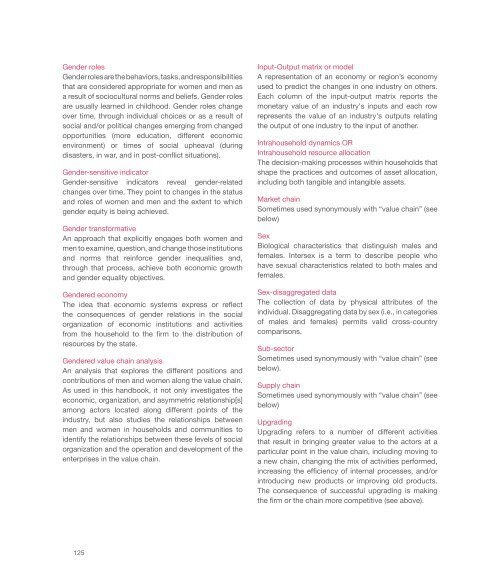promoting gender equitable opportunities in agricultural ... - weman
promoting gender equitable opportunities in agricultural ... - weman
promoting gender equitable opportunities in agricultural ... - weman
You also want an ePaper? Increase the reach of your titles
YUMPU automatically turns print PDFs into web optimized ePapers that Google loves.
Gender rolesGender roles are the behaviors, tasks, and responsibilitiesthat are considered appropriate for women and men asa result of sociocultural norms and beliefs. Gender rolesare usually learned <strong>in</strong> childhood. Gender roles changeover time, through <strong>in</strong>dividual choices or as a result ofsocial and/or political changes emerg<strong>in</strong>g from changed<strong>opportunities</strong> (more education, different economicenvironment) or times of social upheaval (dur<strong>in</strong>gdisasters, <strong>in</strong> war, and <strong>in</strong> post-conflict situations).Gender-sensitive <strong>in</strong>dicatorGender-sensitive <strong>in</strong>dicators reveal <strong>gender</strong>-relatedchanges over time. They po<strong>in</strong>t to changes <strong>in</strong> the statusand roles of women and men and the extent to which<strong>gender</strong> equity is be<strong>in</strong>g achieved.Gender transformativeAn approach that explicitly engages both women andmen to exam<strong>in</strong>e, question, and change those <strong>in</strong>stitutionsand norms that re<strong>in</strong>force <strong>gender</strong> <strong>in</strong>equalities and,through that process, achieve both economic growthand <strong>gender</strong> equality objectives.Gendered economyThe idea that economic systems express or reflectthe consequences of <strong>gender</strong> relations <strong>in</strong> the socialorganization of economic <strong>in</strong>stitutions and activitiesfrom the household to the firm to the distribution ofresources by the state.Gendered value cha<strong>in</strong> analysisAn analysis that explores the different positions andcontributions of men and women along the value cha<strong>in</strong>.As used <strong>in</strong> this handbook, it not only <strong>in</strong>vestigates theeconomic, organization, and asymmetric relationship[s]among actors located along different po<strong>in</strong>ts of the<strong>in</strong>dustry, but also studies the relationships betweenmen and women <strong>in</strong> households and communities toidentify the relationships between these levels of socialorganization and the operation and development of theenterprises <strong>in</strong> the value cha<strong>in</strong>.Input-Output matrix or modelA representation of an economy or region’s economyused to predict the changes <strong>in</strong> one <strong>in</strong>dustry on others.Each column of the <strong>in</strong>put-output matrix reports themonetary value of an <strong>in</strong>dustry's <strong>in</strong>puts and each rowrepresents the value of an <strong>in</strong>dustry's outputs relat<strong>in</strong>gthe output of one <strong>in</strong>dustry to the <strong>in</strong>put of another.Intrahousehold dynamics ORIntrahousehold resource allocationThe decision-mak<strong>in</strong>g processes with<strong>in</strong> households thatshape the practices and outcomes of asset allocation,<strong>in</strong>clud<strong>in</strong>g both tangible and <strong>in</strong>tangible assets.Market cha<strong>in</strong>Sometimes used synonymously with “value cha<strong>in</strong>” (seebelow)SexBiological characteristics that dist<strong>in</strong>guish males andfemales. Intersex is a term to describe people whohave sexual characteristics related to both males andfemales.Sex-disaggregated dataThe collection of data by physical attributes of the<strong>in</strong>dividual. Disaggregat<strong>in</strong>g data by sex (i.e., <strong>in</strong> categoriesof males and females) permits valid cross-countrycomparisons.Sub-sectorSometimes used synonymously with “value cha<strong>in</strong>” (seebelow).Supply cha<strong>in</strong>Sometimes used synonymously with “value cha<strong>in</strong>” (seebelow)Upgrad<strong>in</strong>gUpgrad<strong>in</strong>g refers to a number of different activitiesthat result <strong>in</strong> br<strong>in</strong>g<strong>in</strong>g greater value to the actors at aparticular po<strong>in</strong>t <strong>in</strong> the value cha<strong>in</strong>, <strong>in</strong>clud<strong>in</strong>g mov<strong>in</strong>g toa new cha<strong>in</strong>, chang<strong>in</strong>g the mix of activities performed,<strong>in</strong>creas<strong>in</strong>g the efficiency of <strong>in</strong>ternal processes, and/or<strong>in</strong>troduc<strong>in</strong>g new products or improv<strong>in</strong>g old products.The consequence of successful upgrad<strong>in</strong>g is mak<strong>in</strong>gthe firm or the cha<strong>in</strong> more competitive (see above).125










